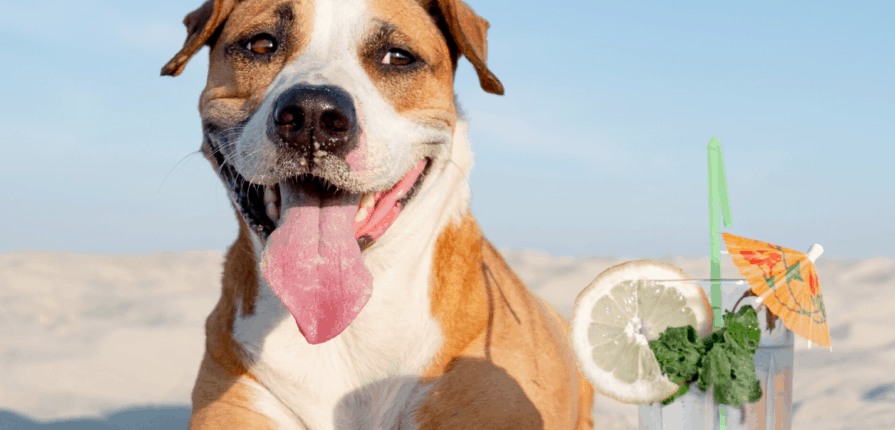
How to Prevent Heat Stroke in Dogs:
We walk and run dogs in Miami for a living. Making sure our precious pups are safe during our notoriously hot weather is a MUST. That’s why our dog walkers and runners are trained to prevent heatstroke by knowing the types and symptoms of heat injury. They are also trained in how to keep dogs well-hydrated and instructed to keep them to the shade, off the asphalt, and to refrain from running in 90 degree weather. We also encourage soaking the pet with cool water on extra hot days. We’ll be sharing these details with you so that you, too, can protect your dogs during the hottest months in Miami!
Hyperthermia and Heat Stroke: what are they?
Hyperthermia means that your pup or cat has overheated and has an elevated temperature. Normal body temperature range for your pup is between 100.4 and 102.5, and for kitties it is. Anything above that can mean hyperthermia has set in, which can lead to heatstroke, a life-threatening situation.
Definition of heat stroke:
When temperatures go into 103 degrees and keep going up, the body can’t regulate. We will see petechiae (blood vessels start to burst) on the surface (a pup’s belly) and internally. Professionals also refer to this as DIC, when the blood vessels burst in the intestines and the kidneys stop functioning and there is organ failure. A pup may poop out blood, their nose will bleed, and death is imminent.
Causes: High body temperatures (103º to 105º and above) and stress can cause a pet to go into heatstroke. This can be caused by being in a hot car or taking a jog at noon and lack of shade during a hike. However, heat stroke is most often caused by leaving your dog or cat in the car for a “few minutes” while you run into the store and by extreme temperatures and lack of water. Temperatures can reach 150 degrees Fahrenheit inside a car within 15 minutes in warm weather- it is never a good idea to leave your pup in the car! Severe heat stroke can damage internal organs- prevention is where it’s at! Remember also that dogs cool themselves by panting. St. Bernards, Bulldogs, Pekinese and other breeds with “pug” or short-nosed faces are more susceptible to heatstroke, even in moderate temperatures.
“Signs & Symptoms” of Hyperthermia and Heat Stroke

Signs of hyperthermia include: Excessive and loud panting, bright red gums and tongue (initially, then turn purple but don’t wait for it to get that bad!), muscle tremors, petechia, vomiting, weakness, pets may have seizures, be conscious, semiconscious or unconscious.
-
- Uncontrollable Panting
- Rapid Heart Rate
- Foaming
- Vomiting
- Lethargy
- Mucous Membrane & Gums: initially bright red with Capillary Refill Time (CRT) being more than 2 seconds.
- Petechiae
Actions for Survival
Heat stroke- You must try to cool them off as you take them to their vet, so start by getting them into a cooler area. Cool your pet down with whatever you have available. A hose works great. You can also place your pet in a cool well-ventilated space nd wrap them in a damp sheet. Only use room temperature water, no ice!
Why no ice? A dog’s temp is normally 101 degrees Fahrenheit; during heat stroke, it can rise above 103 degrees. Applying ice will burn their skin and constrict blood vessels. We want to bring the temperature down slowly or it will cause other problems. As soon as temperature is 103, take off everything you’re using to bring down the temperature (ex: damp sheet) as it will continue to go down.
For heat stroke: you must take your dog to the veterinarian as this is a life-threatening emergency. Getting them into a car with air conditioning until they’re arrived at their veterinarian is good- but don’t blow air right on them, they just need the external temp to be lower. Continue to cool until your pet stops panting. Use a digital thermometer to monitor core temperature until it hits 103. You can use a cooling towel to help lower the pet’s temperature. Transport to the nearest emergency animal clinic or your veterinarian.
Best Practices for Walking Dogs in Miami:

How do we prevent heat injuries while we walk dogs in Miami?
- Carry water for your pooch on long walks, especially when out in our Florida sun! There are plenty of options, such as taking a water bottle or a dog-friendly collapsible water pouch, which makes it so easy to give your dogs the water they crave and need during their walks. Just as important, please make sure they do not drink any standing water or water from our canals and ponds during their walks; you never know if there are bacteria or other harmful substances like motor oil, etc… in it.
- Hydrate your dog the day before a long run… as well as the morning of their exercise! Think of them as mini-humans with similar hydration needs.
- Do not feed your dog any food or treats anywhere from an hour to an hour and a half before your run. Feeding them before strenuous exercise has been correlated with Bloat, which is lethal to dogs and requires immediate veterinary care. Our dog walkers and runners are strictly instructed to NOT run any dogs who have been too close to their exercise time in order to preserve the dogs’ health.
- Stay in the shade as much as possible! Asphalt heats up quickly and may harm the pads on your dog’s paws. A quick exercise to determine whether your pup can handle the heat? Place your hand on the asphalt. If you can’t keep your hand on it for 4 seconds without feeling pain, your dog should not be running on that surface. We try to stay on grass (keeping an eye out for lawns freshly-sprayed with pesticide, a very common sight in Miami). You can also use Musher’s Secret, an all-natural, non-toxic salve, to coat the pads of your pups’ paws and protect them from extremely hot roads and pavement.
- Watch for Dog Heat Exhaustion: The sun in Miami gets to be too much for us; imagine what it’s like for your furry pals… not to mention, for our beloved brachycephalic breeds like Pugs, Boxers, and Bullies. Heat exhaustion is potentially fatal, and preventable if you follow our guidelines above. We watch our dog running and walking clients constantly during our runs, and will not run dogs when it’s over 90 degrees. Again, during your walk, watch for:
-
-
- Brick-red gums
- Excessive panting
- Thick, sticky, and foamy saliva
-
If you see any of this, get your pup home and cooled off as soon as possible. If your pup’s temperature is above 103, you must take him to the vet.
Please let us know if you have any questions or comments, and how else we can help!

A founding member of the Equipaws family, Frankie can mostly be found working behind the scenes, helping co-create online branding, managing several social media accounts, designing brand collateral, writing copy, and managing events. She also fills in for pet sitters and dog walkers when needed in Palmetto Bay, Pinecrest, and South Miami. Her own small pack consists of Boots the Shih Tzu mix and Nutmeg the Chiweenie.


[…] you think your dog may be suffering from heat stroke, it’s important to act quickly. Important: do not use ice to cool them down! You will […]